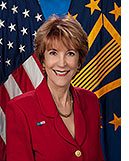
Lance Cpl. Carlin Warren
Meet the Woman in Charge of Customer Service for Millions of Vets
Lynda Davis, VA's chief veteran experience officer, will continue working on Vets.gov and getting real-time feedback for veterans.
Customer service is top of mind today for complex organizations.
Consider United Airlines’ recent public relations fiasco, in which the company apparently acted in a legal manner by removing a passenger from an overbooked flight yet did so in a style that alienated customers and shareholders. As a result, United lost hundreds of millions of dollars, became a pop culture meme in the worst way possible and its reputation among airlines is immeasurably damaged.
Few organizations are as large or complex as the Department of Veterans Affairs, an agency with more than 300,000 employees and a mission to provides benefits, health care and other services to millions of veterans each year.
Rocked by a series of scandals and disability claims backlogs two years ago, VA’s brand suffered as did its perception among veterans—VA ranked among the worst-performing brands in Forrester’s Customer Experience Index. Then-Secretary Robert McDonald responded by creating a customer service wing within the agency, headed by its first-ever chief veteran experience officer, Tom Allin.
Earlier this month, VA Secretary David Shulkin appointed Dr. Lynda Davis to replace Allin. As such, Davis is now in charge of customer service for more than 9 million veterans who receive benefits or services annually from VA.

Nextgov and Davis discussed via email her new role and responsibilities, and what priorities she plans to focus on in the coming months.
Nextgov: We’ve been reporting on a lot of efforts that seemed to begin in the Veteran Experience Office; a real-time veteran analytics’ pilot and call center improvements, for example. What are your priorities?
Lynda Davis: The Veterans Experience Office’s number one priority is to provide leaders and managers with access to the ‘voice’ of our veterans, their families, caregivers and survivors to ensure policies and programs at VA promote the consistent delivery of high-quality support and services while utilizing the best practices in customer experience. Within that context, we are helping the Secretary meet his priorities and the directives of the President’s executive order and Office of Management and Budget. Some of the immediate things VEO is doing are:
1. VEO will continue to help VA modernize through further development and refinement of Vets.gov, which is designed and programmed by top private-sector technologists from the United States Digital Services, integrated data systems through Vet360, and our continuing contact center modernization. These efforts are crucial to providing our customer an easy experience in obtaining VA information and services.
2. Delivering mechanisms to allow VA to focus its resources more efficiently through our real-time, web-based feedback tool, transactional and enterprise measurement capability. We have a unique ability to measure activities across all of VA horizontally and down through the organization from the strategic/enterprise level to operational/business lines and finally to the tactical/execution level. VEO can provide VA leadership the data required to make informed business decision that will improve the Veteran experience and their care and benefits outcomes.
Nextgov: What’s the approximate size of the VE wing, and how many personnel will you oversee? Is VEO truly a national office or are staff entirely based near Washington?
Davis: VEO is a national office with a field presence across the nation. VEO is allocated approximately 182 personnel; about 120 government personnel are currently on board, 92 of which are deployed nationwide. Additionally, 25 personnel are detailed to the office supporting technology program management.
Nextgov: What lessons has VA learned thus far in creating VEO and the role of chief veteran experience officer, and how is VA moving to become a top customer service provider?
Davis: To meet the goals of the Secretary to serve all veterans, their families, caregivers and survivors within the context of the executive order, VEO must assist VA to be bold, to anticipate emerging requirements and to execute.
VEO must not only be poised to capture feedback but to be successful it must also support action. Its information must be disseminated across the agency to inform decision-making and support process improvement. VEO’s impressive data capturing and analysis capability must be translatable at the transactional level, must lead to executable action, and must promote continuous improvement to prove its value. Our staffing of diverse skill sets reflects that.
Nextgov: Technology underpins much of what government does to provide a mix of digital and other services to citizens. How will you look at technology as a tool to improve the veteran experience? Are there examples you can share, either of efforts the department has planned or potential pilots in the works?
Davis: VA wants to offer a consistent, unified experience that is the same no matter how or where the customer interacts with VA: text, desktop, mobile, telephone or email. We want the experience to be easy and effective. Veterans shouldn’t be forced to navigate to us, but the opposite.
Some of the things we are working on with our VA partners are:
a. Vet360 - This is the backbone of the consistent multi-channel experience. Vet360 will integrate common veteran data enterprise-wide so each organization will view the same veteran information. Veterans will no longer have to update their information several times or feel like one side of VA is not talking to the other. This is the first and most crucial element to a unified VA experience.
b. MyVA311- In partnership with Veterans Health Administration, Veterans Benefits Administration and the National Cemetery Administration, VEO stood up MyVA311 (1-844-MyVA311), which provides a single entry point for veterans, family members, caregivers and survivors to connect with VA, 24/7. This national toll-free number serves as a one-stop option for veterans and their families to access emergency and nonemergency VA services and information.
Nextgov: Do you have any goals to strive for in the coming months and years? What’s your vision for the department and how would it look if all goes accordingly?
Davis: VEO’s goal is to empower VA to become the premier customer service organization in government by influencing strategic decisions from the Veterans perspective.
Internally, VEO must create strong partnerships within the department’s agencies to drive a culture shift of viewing all services and policies from the customer’s point of view.
Externally, VEO will continue partnering across government and non-government veteran service providers, especially at the state and local levels, to create caring communities of capability and collaboration that address the needs of Veterans, their families, caregivers and survivors holistically.
Nextgov: Federal agencies often turn to the private sector for ideas and best practices in customer service, but in recent years, we’ve seen an increase in cross-agency collaboration. Where are you looking for innovation?
Davis: My approach to health and human services delivery has always been based on partnerships. I look forward to building closer relationships with the growing number of federal and state agency customer experience offices, but we also cannot discount the incredible service programs that already exist within VA.
VA has 1,221 outpatient sites, 300 Vet Centers, 144 VA hospitals, 133 national cemeteries and 56 VBA regional offices. Someone, somewhere within VA has already figured out how to solve a specific challenge. Our VEO field teams are actively seeking out those best practices for a greater dissemination.
We owe it to our veterans, their families, caregivers, survivors and the taxpayers to use state of the art knowledge and tools in the field of customer experience whether it comes from other organizations or from the private sector. The true value of our efforts, however, must be determined by those who we touch each and every day.
